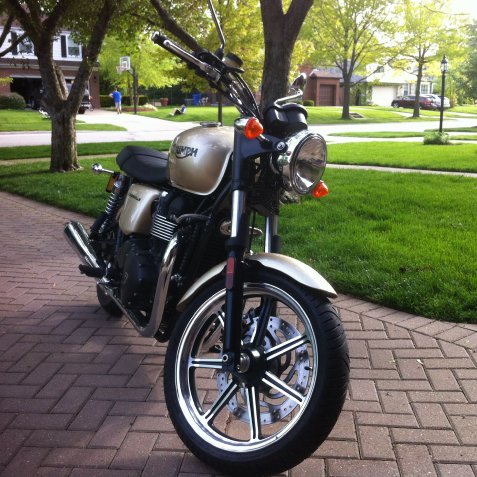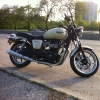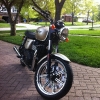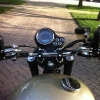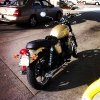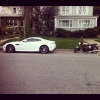Like Steve McQueen: Triumph Bonneville brings 60s cool to the new millennium
The Triumph Bonneville is etched into motorcycle lore. When it was created in 1957, it was one of the world’s fastest bikes. The epitome of fast and loud, it’s the original bad boy bike from across the pond. In 2001, Triumph brought it back for a new generation, but times have changed. The superbike of yesteryear is but a mildly fast ride today; that doesn’t mean that the bike has lost any of its legendary qualities though. So, can a retro-styled bike deliver an exhilarating riding experience without the latest tech and stratospheric horsepower numbers? In short, yes it can.
The Bonneville comes in three separate trims depending on how much you have to spend and the look you are going for. The Base and SE have cast wheels, and the SE adds two-tone paint and a tachometer. The T100 adds wire wheels, a different two-tone paint scheme and more chrome for a definite ‘60s vibe. The Scrambler is styled like a vintage desert sled and the Thruxton looks like a café racer of old. For this test, I took out the base Bonneville, no frills and no extras, to see how it performs.
Classic looks revisited
The Bonneville is not just a motorcycle, but a snapshot in time. Mods vs. Rockers, café racers, swinging ‘60s, Steve McQueen, Bob Dylan; the Triumph Bonneville was around during a truly exciting period in culture and history. To bring this look back may seem like a no-brainer, but it carries a certain amount of risk in that it can’t be a carbon copy or too different than the original. The base Bonneville strikes a good balance. Its cast wheels bring the look up to around the mid-70s, but don’t age the bike too much compared to modern machinery. And like your boomer parents, the Bonneville is plumper today than it was back then both visually and on the scales.
Park anywhere, though, and you might as well be stepping out of a time machine. People continually ask not where to get the bike, but how old is it, where to get one restored, and how much it costs. Slathered in gold paint, the vintage look is played up, but people are honestly surprised when you tell them it’s brand new; and for much less than they think. You can walk out the door with a brand new base Bonneville for $7699. However, all the good looks in the world are useless if the Bonnie is not an engaging ride. All other retro bikes lean on their classic looks to not provide a modern riding experience, but does the Triumph do the same?
Do the ton, eventually
Motivated by an 865cc parallel-twin, the Bonneville has the same type of motor as it did all those years ago, but with more displacement. The powerplant boasts 67hp, 50lb. ft. of torque attached to a five-speed transmission, but those are just numbers. In real life, this means more thrust than your average cruiser, but not enough to warp you into another dimension like the Diavel we just tested.
For all the heritage and history, though, the motor doesn’t want to remind you of any of it. It’s smooth almost to a fault, and with stock exhausts, much too quiet. Fire it up and you’d think you accidently got on somebody’s scooter. Get an aftermarket pipe and she’ll sing the song of the ‘60s all day, but in stock format, the motor has too little personality for what the looks promise.
Lack of bravado aside, I bet McQueen would have gladly traded noise for the modern parts on the bike, such as the fuel injection and the disk brakes. Plus, those British reliability quirks are long gone. And when I say quirks, I mean nightmares, such as electrical systems that didn’t provide power to anything, and engines that would gleefully leak oil all over your driveway. For an example of how British machines used to be, watch the last few episodes of “Mad Men.” To see how those fears are no longer true, ride a new Bonneville.
Like the engine, there’s nothing groundbreaking about the bits that control handling either. Brakes are two-piston Nissin units on the front and rear, and the forks are conventional. But nothing revolutionary needed to be done. The ride is composed, turn in – with the cast wheels – is more nimble than I would have thought, and brakes are confident without being grabby. Basically, the perfect ingredients needed for an urban commute.
You sit comfortably, ride smoothly and brake quickly, but the bike performs with a boundless enthusiasm. The Bonneville doesn’t lug itself around like a cruiser, but is light on its feet without being jittery and always communicates just enough feedback. It’s the perfect bike for just about any type of rider.
Retro without trying too hard
Usually, when a bike manufacturer takes a model from the back catalog, they are asking you to sacrifice looks for function. With the Bonneville, this is not the case. Which is a good thing, because after a while, the novelty of ‘60s aesthetics would grow tiresome if the bike was awful to ride. Luckily, with the Bonneville, you can look like Steve McQueen and continually surprise yourself with the bikes abilities. It’s no 200mph superbike, but with an attitude all its own and wrapped around approachable dynamics for every kind of rider, it doesn’t need to be.
Related Posts
You can follow us on Twitter and Facebook for content updates. Also, sign up for our email list for weekly updates and check us out on Google+ as well.
Posted in: Lifestyle, Motorcycles




